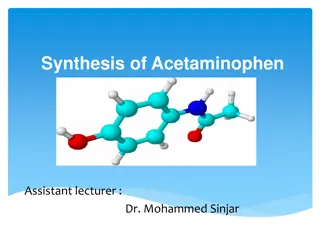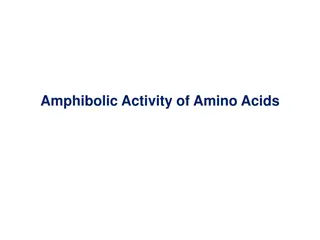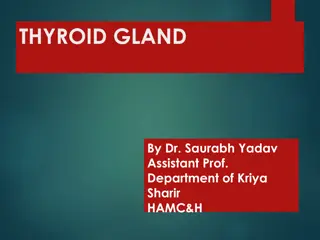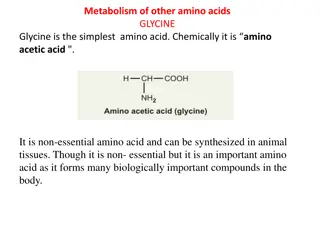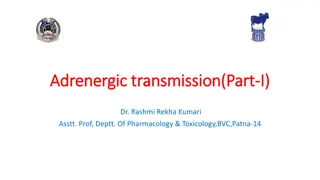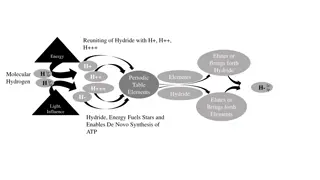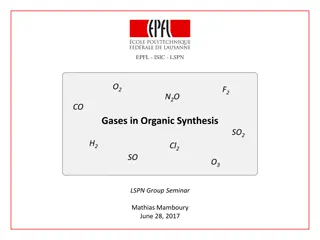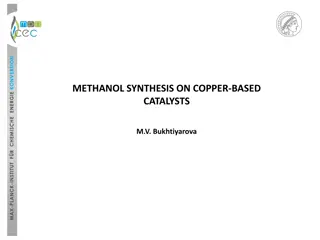Overview of Heme Synthesis and Porphyrias
Heme is a crucial component present in various essential proteins in the body, such as hemoglobin, myoglobin, and cytochromes. The synthesis of heme takes place in multiple steps involving different organelles and enzymes in the cell. Porphyrias are a group of disorders related to heme synthesis, characterized by an abnormal accumulation of porphyrins. Understanding the structure and synthesis of heme is vital for comprehending the implications of porphyrias on human health.
Download Presentation

Please find below an Image/Link to download the presentation.
The content on the website is provided AS IS for your information and personal use only. It may not be sold, licensed, or shared on other websites without obtaining consent from the author.If you encounter any issues during the download, it is possible that the publisher has removed the file from their server.
You are allowed to download the files provided on this website for personal or commercial use, subject to the condition that they are used lawfully. All files are the property of their respective owners.
The content on the website is provided AS IS for your information and personal use only. It may not be sold, licensed, or shared on other websites without obtaining consent from the author.
E N D
Presentation Transcript
Heme is presentin: Hemoglobin. Myoglobin. Cytochromes. Peroxidase. Catalase. Tryptophanpyrrolase. Nitric oxidesynthase.
Hemoglobin contain four Hemegroups. Each Heme holds one iron atom, each iron atom holds one molecule of oxygen. Four oxygen molecules. .250 million molecules of hemoglobin per cell. Each red blood cell carries one billion molecules of oxygen.
Organs mainly involved in H e m esynthesis? variable constant
cytosol mitochondria
Heme Heme degradation Hemesynthesis Bilepigments+ iron
How is the structure of porphyrin? Porphyrins are cyclic compounds formedby the linkage of four pyrrole rings through methyne (=HC ) bridges A characteristic property of porphyrins isthe formation of complexes with metal ions bound to the nitrogen atom of the pyrrole rings
Step-1(mitochondria( From citricacidcycle Non essential aminoacid Succinyl-CoA Glycine ( Pyridoxal phosphate activates) condensation reaction ALA synthase CoA-SH -amino- -ketoadipic acid
Step-2(mitochondria) -amino- -ketoadipic acid decarboxylationreaction ALAsynthase (rate controlling enzyme - porphyrin biosynthesis liver) -aminolevulinate (ALA)
Step-3(cytosol( ( 2molecules) -aminolevulinate(ALA) ALAdehydratase 2H20 zinc-containing enzyme andis sensitive to inhibition bylead. (1) porphobilinogen (PBG( First precursor of pyrrole
Step-4 (cytosol( (4molecules) porphobilinogen (PBG) AIP condenses uroporphyrinogenI synthase 4NH3 HydroxymethylbilaneHMB lineartetra pyrrole PBGdeaminase HMB synthase
Step-5(cytosol( Hydroxymethylbilane (HMB( uroporphyrinogenIII synthase UroporphyrinogenI HMB cyclizesspontaneously UroporphyrinogenIII CEP Forms under normalconditions
Step-6(mitochondria( uroporphyrinogenI uroporphyrinogenIII 6H 6H light Uroporphyrinogen decarboxylase light UroporphyrinIII UroporphyrinI coproporphyrinogenI coproporphyrinogenIII 6H 6H light light PCT CoproporphyrinIII CoproporphyrinI
Step-7(mitochondria( coproporphyrinogenIII Coproporphyrinogen oxidase HCP ProtoporphyrinogenIII
Step-8(mitochondria( ProtoporphyrinogenIII Protoporphyrinogen oxidase Por.variegata ProtoporphyrinIII
Step-9(mitochondria ( ProtoporphyrinIX Hemesynthase Ferrochetalase H.protoporphyria Heme
Regulation of HemeSynthesis Heme inhibits the synthesis of ALAsynthase repression mechanism ALA synthaseis also allosterically inhibitedby hematin. Thecompartmentalizationof theenzymes, makes the regulationeasier. The steps catalyzed by ferrochelatase andALA dehydratase are inhibited bylead.
Regulation of HemeSynthesis Drugs like barbituratesinduce hemesynthesis. Barbiturates require the hemecontaining cytochrome P450for their metabolism. Out of the totalhemesynthesized, two thirds are used for cytochrome P450production. INH (Isonicotinic acid hydrazide) that decreases the availability of pyridoxal phosphate may also affect hemesynthesis.
Regulation of HemeSynthesis High cellular concentration of glucose prevents induction of ALA synthase. This isthe basis of administration of glucose to relieve the acute attack ofporphyrias. Regulation in the erythroid cells: The enzyme ALA synthase does not appear to control the hemesynthesis in the erythroid cells. Uroporphyrinogen synthaseand ferrochelatse mostly regulate hemeformation in thesecells.
What are porphyrias? Porphyria refers to a growing collection of disorders in which there are abnormalities in the enzymes involved in Hemesynthesis. Although porphyrias are not veryprevalent, physicians must be aware ofthem.
What are the causesof porphyrias? There are at least eight steps in the production of Heme, and at least eight different types of porphyria can result when an enzyme malfunctions and levels of intermediate substances rise tobeyond what the body is needed.
Porphyriasclassification This classification is based on the majorsite, where the enzyme deficiency ismanifested. The porphyrias are classified as erythropoietic or hepatic, depending on whether the enzyme deficiency occurs inthe erythropoietic cells of the bone marrow or in theliver. Hepatic porphyrias can be further classified as chronic or acute.
Porphyriasclassification In general, individuals with an enzyme defect prior to the synthesis of the tetrapyrroles manifest abdominal and neuropsychiatricsigns. Whereas those with enzyme defects leading to the accumulation of tetrapyrrole intermediates photosensitivity. That is, their skin itches and burns when exposed to visiblelight. show
Acute intermittentporphyria 4molecules porphobilinogen (PBG( This disorder occurs due to the deficiencyof the enzyme uroporphyrinogen Isynthase. condenses Characterized by increased excretionof porphobilinogen and6-aminolevulinate. Uroporphyrinogen I synthase Theurine getsdarkenedon exposuretoair due to the conversion of porphobilinogen to porphobilinandporphyria. Hydroxymethylbilane HMB(lineartetrapyrrole)
Other characteristic features ofAIP Usually expressed after puberty inhumans. The symptoms include abdominal pain, vomitingand cardiovascularabnormalities. The neuropsychiatric disturbancesobserved. The symptoms are more severe after administrationof Drugs: e.g.Barbiturates. These patients are not photosensitive sincethe enzyme defect occurs prior to the formation of uroporphyrinogen.
Congenital erythropoieticporphyria characteristicfeatures Rare congenital disorder Autosomalrecessive Confined to erythropoietic tissues. The individuals excrete uroporphyrinogen I and coproporphyrinogen I which oxidize respectively touroporphyrin I and coproporphyrin | . red pigments. Hydroxymethylbilane uroporphyrinogenIII synthase uroporphyrinogenIII The patients arephotosensitive. Increasedhemolysis.
Porphyriacutaneatarda uroporphyrinogenI uroporphyrinogenIII Uroporphyrinogen decarboxylase coproporphyrinogenI coproporphyrinogenIII This is also known ascutaneous hepatic porphyria. Themost common porphyria . Usually associated with liver damage caused byalcohol overconsumption or ironoverload. The partial deficiency of the enzyme uroporphyrinogen decarboxylase appears to be responsible for theoccurrence of porphyria cutaneatarda.
Porphyria cutaneatarda The other characteristic features include: Increased excretion of uroporphyrins l andlll and rarelyporphobilinogen. Cutaneous photosensitivity is the mostimportant clinical manifestation of thesePatients. Liver exhibits fluorescence due to high concentration of accumulatedporphyrins.
Hereditary cutaeniatarda coproporphyrinogenIII Coproporphyrinogen oxidase ProtoporphyrinogenIII Coproporphyrinogen lll and other intermediates (ALA andPBC) excreted in urine andfeces. The patients of hereditary coproporphyria arephotosensitive. Theyexhibit the clinical manifestations observed in the patients of acute intermittentporphyria. Infusionof hematinis usedto control this disorder. Hematin inhibits ALA synthaseand thus reduces the accumulation of variousintermediates.
Variegateporphyria ProtoporphyrinogenIII Protoporphyrinogen oxidase ProtoporphyrinIX The enzyme protoporphyrinogen oxidase is defective in this disorder. Due to this blockade, protoporphyrin lX required for theultimate synthesis of Heme is notproduced. Almost all theintermediates(porphobilinogen,coproporphyrin, uroporphyrin,protoporphyrin etc.)of Hemesynthesisaccumulate in the body andareexcretedin urine andfeces. Theurineof thesepatients iscolouredandtheyexhibit photosensitivity.
Protoporphyria ProtoporphyrinIX Hemesynthase Ferrochetalase Heme This disorder, also known aserythropoieticprotoporphyria Deficiency of the enzymeferrochelatase. Protoporphyrin lXaccumulates in the tissues and is excreted into urine andfeces. Reticulocytes (young RBC) and skin biopsyexhibit red fluorescence.
Acquired porphyrias(toxic( The porphyrias, though not inherited, may beacquired due to the toxicity ofseveral compounds. Exposure of the body to: Heavy metals e.g.lead, Toxic compounds e.ghexachlorobenzene. Drugs. E.g.Griseofulvin inhibits many enzymes inheme synthesis. Theseinclude: ALAdehydratase. Uroporphyrin Isynthase. Ferrochetalase.
Diagnosis The best time to attempt diagnosis is whenthe symptoms areactive. Porphyria sufferers are affected by anythingthat can alter the functioning of the deficient enzymes. Disease can occur to different degrees. Some people are affected so slightly that the diagnosis is neverconsidered. Herbs, drugs, alcohol and even hormones can produce acute attacks by interfering withenzyme function.
Diagnosis Lab tests are required to make adefinitive diagnosis of porphyria and to determine which form of the disease youhave. If your doctor suspects porphyria, he orshe may recommend thesetests: Urine , blood and stool: Examinationfor variousporphyrins. Spectrophotometry: Is Used to Testfor Porphyrins & Their Precursors Coproporphyrins anduroporphyrins.
Urinetest: If you have a form of acute porphyria, a urinetest may reveal elevated levels of two substances: porphobilinogen and delta-aminolevulinicacids, as well as other porphyrins. Blood test: If you have a form of cutaneous porphyria, a blood test may show an elevation in the level ofporphyrins in your bloodplasma. Stool sampletest: Analysis of a stool sample may reveal elevatedlevels of someporphyrinsthatmaynotbedetectedinurine samples. This test may help your doctor determine your specific type ofporphyria.
T o demonstrate porphyrins, UV fluorescence is the besttechnique. The presence of porphyrin precursor in urineis detected by Ehrlich sreagent. When urine is observed under ultravioletlight porphyrins if present, will emit strong red fluorescence. Spectrophotometry :Is Used to Test for Porphyrins & Their PrecursorsCoproporphyrins and uroporphyrins. Use of appropriate gene probes has made possible the prenatal diagnosis of some ofthe porphyrias.














